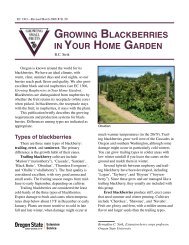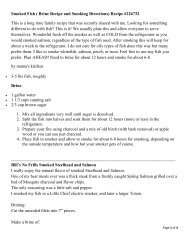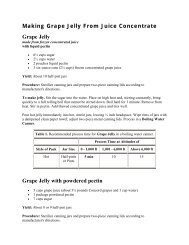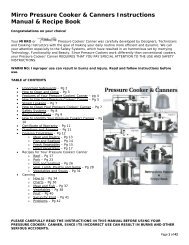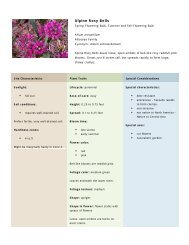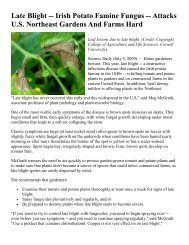You also want an ePaper? Increase the reach of your titles
YUMPU automatically turns print PDFs into web optimized ePapers that Google loves.
POTTED PLANTS-When you receive your potted plants, you may find some of the<br />
leaves appear to be yellowing or perhaps even dead. But that doesn't mean the plants are<br />
dead. As long as the root system is healthy, upper foliage will soon regenerate.<br />
Your potted plants require little attention before transplanting:<br />
• Check to make sure the planting medium is still moist and water if the top is dry.<br />
Groom the plant by pinching off any less-than-healthy leaves (for example, leaves that<br />
are yellowed or withered).<br />
• Transplant potted plants to their new home as soon as possible after your shipment<br />
arrives.<br />
• Remove plants from their shipping pots by lightly squeezing or tapping the sides of<br />
the container to loosen the planting medium in which the plant has been growing. Then,<br />
invert the pot, gently shake the plant loose and proceed with planting.<br />
Plants which seem to be tightly bound to their pots may be "root bound." However, they<br />
are easy to remove and prepare for planting:<br />
• First, squeeze the container to loosen the compacted root ball inside.<br />
• Invert the pot and shake the plant out of the container.<br />
• If you find a mass of roots tightly woven into the planting medium, cut or tear off the<br />
bottom third of the root ball.<br />
Squeeze, invert & shake Cut offbottom third<br />
of the root ball<br />
t.<br />
Score s ides of root ball<br />
• Then, using a knife or trowel, score a vertical mark on all four sides of the root ball.<br />
Even though you will be cutting some of the roots by scoring, loose ends will have a<br />
tendency to grow outward into the surrounding soil, while unscored roots will continue<br />
to grow in the root ball itself after planting and may cause decreased vigor.<br />
GROUND COVERS-Ground cover plants prefer deeply worked, properly fertilized<br />
soil which is free from weeds.<br />
Dig individual planting holes and plant each ground cover plant as outlined above for other<br />
potted plants. To create the most natural effect, stagger your planting so the individual<br />
plants aren't lined up like ranks of soldiers. If your planting will be on a slope, follow the<br />
contours with staggered spacing, leaving a depression around each plant to catch water.<br />
Spread a 1-2" layer of mulch over the area surrounding the plants, being careful not to<br />
bury them. This will help retain moisture in the soil and retard weed growth. Maintain the<br />
mulch covering until your ground cover plants have spread to cover the entire planting site.<br />
BAREROOT GROUND COVERS-Some bareroot plants may need to be separated<br />
before planting. When dividing clumps of plants make sure each lead has sufficient roots<br />
on each divided bareroot plant to insure successful growing.<br />
PAGE 6




